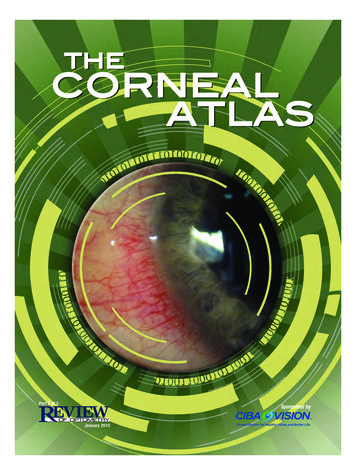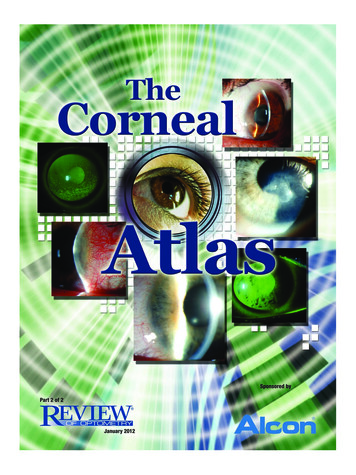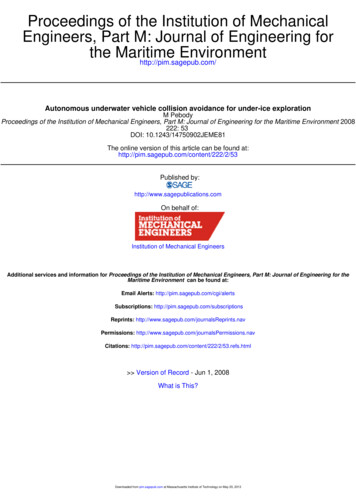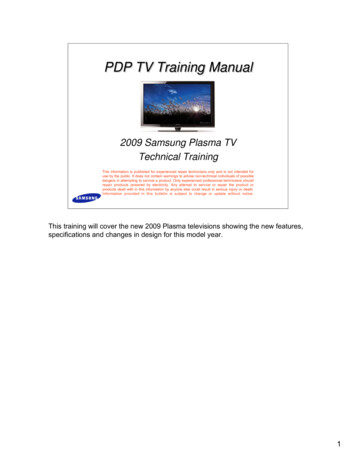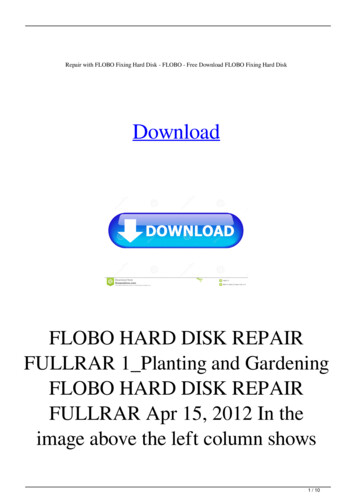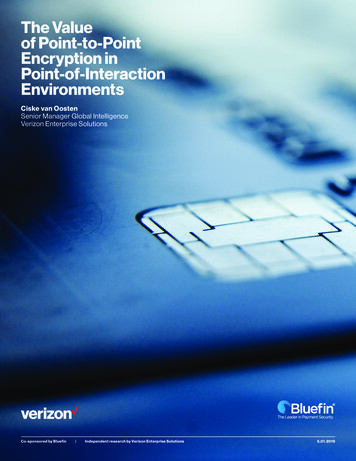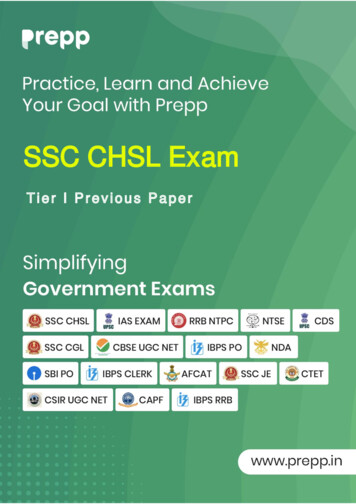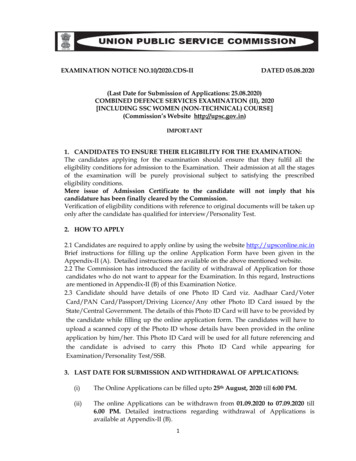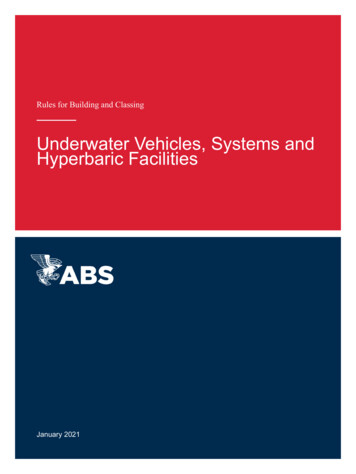
Transcription
NTIS # PB94-121936SSC-370UNDERWATER REPAIRPROCEDURES FOR SHIPHULLS(FATIGUEAND DUCTILITYOFUNDERWATER WET WELDS)This dccurnenthss been approvedfor public releasesnd salq itsdistrihnion is unlimitedSHIP STRUCTURE1993COMMITTEE
SHIP STRUCTURECOMMllTFFThe SHIP STRUCTURE COMMllTEEis constituted to prosecute a research program to improve the hull structures of ships and othermarine structures by an extension of knowledge pertaining to design, materiafs, and methcds of construction.RADM A E. Henn, USCG (Chairman)Chief, Office of Marine Safety, Swurityand Environmental ProbtionU.S. Coast GuardMr. Thomas H. PeirceMarine Research and DevelopmentCmxdinatorTransportation Development CenterTransporl CanadaMr. H. T. HailerAssaciate Administrator for Shipbuilding and Ship OperationsMaritime AdministrationDr. Donald LiuSenior Vice PresidentAmerican Bureau of ShippingMr. Alexander MalakhoffDirector, Structural IntegritySu roup (SEA 05P)Nava? Sea Systems CommandMr. Thomas W. AllenEngineering Ofker (N7)Military Sealift CommandMr. Warren NethercoteHead, Hydronauti SectionDefence Research Establishment-AtlanticEXFCUTIVECONTRACTINGDIRFCTO OFFICFRTECHNICALR EPRFSFNTATMr. VWliam J. SiekierkaCDR Stephen E. Sharpe, USCGShi Structure CommitteeU. g. Coast GuardSEA 05P4Naval Sea Systems CommandThe SHIP STRUCTURE SUBCOMMllTEEacts for the Ship Structure Committee on technical matters by providing technicalcoordination for determinatirrg the eels and objectives of the program and by evaluating and interpreting the results in terms ofstructural design, construction, an 3 operation.AMERICANMr.Mr.Mr.Mr.BUREAU OF SHIPPINGStephen G. Arrrtson (Chairman)John F. ConIonPhillip G, RynnWilliam HanzelekMILITARY SEALl Mr.Mr.Mr.Mr.COMMANDNAVALSEA SYSTEMS COMMA NDTRANSPORT CANADAMr.Mr.Mr.Mr.Mr.Mr.Mr.Mr.W, Thomas PackardCharles L NullEdward KadalaAllen H. EngleMARITIMEAD MINISTRAT IONU.S. COAST GUARDMr. Frederick SeiboldMr. Norman O. HammerMr. Chao H. LinDr. Walter M. MacleanRobert E. Van JonesRickard A. AndersonMichael W. ToumaJeffrey E. BeachDEFENC NTICJohn GrinsteadIan BaylyDavid L. StocksPeter llmoninCAPT G. D. MarshCAPT W. E. Colburn, Jr.Mr. Rubin ScheinbergMr. H. Paul CojeenESEARDr. Neil PeggLCDR D. O’ReillyDr. Roger HollingsheadMr. John PorterSHIP STRLfCmIRFSURCOMMITFF I IAISON WMRFR sN A TIONAI ACADFMYMARINE BOARDr. Robrt Sielsk?OF SCIENCENATIONAL sO F SCIENCESDr. C. B. KimU, S. NAVAL ACADEMYMr. Peter M. PalermoDr. Ramswar BhattacharyyaWELDINGLL S. COAST GUARD ACA17EMYLCDR Bruce R. Mustains- Y NE;ERGYDACADEMYRESEARCH-COUNCILDr. Martin PragerTE:HNOLOG!&&AMERI CAN IRON ANDSTEEL INSTITUTEDr. William R. TysonMr. Alexander D, WilsonSOCETYO F NAVAL AR CHITECTS AND EARDr. William SandbergCHDr. Yapa D. S. Rajapaske‘1,’h .rWE
COMMllTEE ON MARINE STRUCTURESCommission on Engineering and Technical SystemsNational Academy of Sciences - National Research CouncilThe COMMITTEE ON MARINE STRUCTURES has technical cognizance over theinteragency Ship Structure Committee’s research program.Peter M. Palermo Chairman, Alexandria, VASubrata K. Chakrabarti, Chicago Bridge and Iron, Plainfield, ILJohn Landes, University of Tennessee, Knoxville, TNBruce G. Collipp, Marine Engineering Consultant, Houston, TXRobert G. Kline, Marine Engineering Consultant, Winona, MNRobert G. Loewy, NAE, Rensselaer Polytechnic Institute, Troy, NYRobert Sielski, National Research Council, Washington, DCStephen E. Sharpe, Ship Structure Committee, Washington, DCLOADS WORK GROUPSubrata K. Chakrabarti Chairman, Chicago Bridge and Iron Company, Plainfield, ILHoward M. Bunch, University of Michigan, Ann Arbor, MlPeter A. Gale, John J. McMullen Associates, Arlington, VAHsien Yun Jan, Martech Incorporated, Neshanic Station, NJJohn Niedzwecki, Texas A&M University, College Station, TXSolomon C. S. Yim, Oregon State University, Cotvallis, ORMaria Celia Ximenes, Chevron Shipping Co., San Francisco, CAMATERIALS WORK GROUPJohn Landes, Chairman, University of Tennessee, Knoxville, TNWilliam H Hartt, Florida Atlantic University, Boca Flaton, FLHorold S. Reemsnyder, Bethlehem Steel Corp., Bethlehem, PABarbara A. Shaw, Pennsylvania State University, University Park, PAJames M. Sawhill, Jr., Newport News Shipbuilding, Newport News, VABruce R. Somers, Lehigh University, Bethlehem, PAJerry G. Williams, Conoco, Inc., Ponca City, OK. .
SHIP STRUCTURE COMMITTEE PUBLICATIONS@SSC-354Structural Redundancy for Discrete and Continuous Systems by P. K.Das and J. F. Garside 1990SSC-355Relation of Inspection Findings to Fatigue Reliability by M. Shinozuka1989SSC-356Fatiaue Performance Under Multiaxial Lod by Karl A. Stambaugh,Paul R. Van Mater, Jr., and William H. Munse 1980SSC-357Carbon Equivalence and Weldability of Microalloved Steels by C. D.Lundin, T. P. S. Gill, C. Y. P. Qiao, Y. Wangj and K. K. Kang 199oSSC-358Structural Behavior After Fatiaue by Brian N. Leis 1987SSC-359Hydrodynamic Hull Damping (Phase 1]by V. AnkudinovSSC-360Use of Fiber Reinforced Plastic in Marine Structures by Eric Greene1990SSC-361Hull Strappina of Ships by Nedret S. Basar and Roderick B. HullsSSC-362Shipboard Wave Heiqht Sensor by R. AtwaterSSC-363Uncertainties in Stress Analvsis on Marine Structures by E. Nikolaidisand P. Kaplan 1991SSC-364Inelastic Deformation of Plate Panels by Eric Jennings, Kim Grubbs,Charles Zanis, and Louis Raymond 1991SSC-365Marine Structural Integrity Proarams (MSIP} by Robert G. Bea 1992SSC-366Threshold Corrosion Fatigue of Welded Shipbuilding Steels by G. H.Reynolds and J. A Todd 1992SSC-367Fatigue Technoloav Assessment and Strategies for Fatigue Avoidance inMarine Structures by C. C. Capanoglu 1993SSC-368Probability Based Ship Deslrm Procedures: A Demonstrationby A. Mansour, M. Lin, L Hovem, A Thayamballi 1993SSC-369Reduction of S-N Cumes for Ship Structural Details by K. Stambaugh, D.Lesson, F. Lawrence, C-Y. Hou, and G. Banas 1993SSC-370Underwater Repair Procedures for Ship Hulls (Fatiaue and Ductility ofUnderwater Wet Welds) by It Grubbs and C. ZanisSSC-371Establishment of a Uniform Format for Data Reportinq of StructuralMaterial Properties for Reliability Analysis by N. Pussegoda, L. Malik,and A. DinovitzerNoneShip Structure Committee Publications - A Special 90‘L;‘L‘
SSC-370Underwater Repair Procedures for Ship Hulls (Wet WeId Fatigue & Ductility)Ship Structure Committee “,.’-. ,,.1993
Address Correspondence to:Member Agencies:United States Coast GuardNaval Sea Systems CommandMaritime AdministrationAmerican Bureau of ShippingMilitary Sealift CommandTranspoti CanadaShipStructureCommitteeExecutive DirectorShip Structure CommitteeU. S, Coast Guard (G-Ml/R)2100 Second Street, S.W.Washington, D.C, 20593-0001PH: (202) 267-OOO3FAX: (202) 267-4677An Interagency Advisory AIR PROCEDURES FOR SHIP HULLS ( FATIGUE ANDDUCTILITY OF UNDERWATERWET WELDS)Theuse of underwaterweldingfor the repairof damage below theinwaterlineof a shipor marinestructurehas shave generallyonly beenacceptableas emergencyrepairsand temporary.Uncertaintieswithregardto thelongtermpropertiesof isaddressesspecificallythefatigueperformanceand low tensileelongationpropertiesof underwaterwet weldrepairmethods.The reportconcludeswith recommendationsfor futureresearch.‘C.P*7LA. E. HENNRear Admiral,U.S.CoastGuardChairman,Ship StructureCommittee,
Address Correspondence to:Member Agencies:United States Coast GuardNavalSea Systems CommandMaritime AdministrationAmerican Bureau of Sh&pingMilitay Sealift CommandTransport CanadaShipStructureCommitteeExecutive DirectorShip Struoture Comm” eeU.S. Coast Guard (G-Ml/R)2100 Second Street, S.W.Washington, D.C. 20593-0001PH: (202) 267-0003FAX: (202) 267-4677An Interagency Advisory AIR PROCEDURES FOR SHIP HULLS ( FATIGUE ANDDUCTILITY OF UNDERWATERWET WELDS)The use of underwaterweldingfor the repairof damage below thewaterlineof a shipor marinestructurehas reshave generallyonly beenacceptableas emergencyrepairsand temporary.Uncertaintieswithregardto thelongtermpropertiesof rtaddressesspecificallythefatigueperformanceand low tensileelongationrepairmethods.propertiesof underwaterwet weldThe reportconcludeswith recommendationsfor futureresearch.A. E. HENNRear Admiral,U.S. CoastGuardChairman,Ship StructureCommittee
RtpottTechnical1.Report No.2.T,ri*Acccss3. ROCIPI*R!’IIon Ne.and Subt, ?lr .s.OrganizationNom-RaoortDora6.Perform, ng Organ, Zqt IO. Ledc8.Pmrformqng Orgnn, xat, on Rmpor*Grubbs, Kim and Zartis, CharlesPorf*rmln9Me.May 1993“Underwater Repair Proceduresfor Ship Hulls (Fatigue andDuctility of Underwater Wet Welds)”7. Aurhar onHoSR-133310.and Addrc Corporation2800 Shirlington Road, Suite 600Arlington, Virginia 22206CASDEWa,kUn, t No. (T RAIS)11, Contractor Grsnt NQ,DTCG23-90-C-20005Y1s. TypoofR petr and PorladCev*rcd12. pons r,ng A m-Icy Namo and Addr*ssShip Structure CommitteeU.S. Coast Guwd2100 Second StreetWashington, D.C. 2059315. SupPl menrarYFinal Report14.SponsoringAg*ncyCodaG:MNet* Sponsored by the Ship Structure Committee and its member agencies.lb,AbstruclCommercial ships may experience damage below the waterline from a variety of causes. Dueto the significant costs and the time-consuming nature of unscheduled or emergency drydockingof a ship for repair, there is a clear need for the development of alternate repair methods whichpreclude having to drydock the ship. An area of ship repair which has the potential toaccomplish this objective involves the use of underwater wet welding. A large amount of testinghas been performed in recent years to characterize the properties of underwater wet welds, undindicates that this repair method has promise. This project addresses two significant technicalareas relating to wet welds: 1) fatigue performance and 2) low tensile elongation properties ofwet welds.Fatigue performance was evaluated by testing underwater wet butt welds fabricated in 3/ -inchASTM A 36 steel, using E7014 Type electrodes. The underwater wet welds were fabricated infresh water at a depth of 30 feet, using a wet welding procedure qualified to the standards ofANSI/AWS D3.6-89, for Type B welds. Fatigue testing was performed on transverse weldspecimens, with and without backing bars, subjected to cyclic axial tensile loading.Findings indicated that 1) The S-N data for the underwater wet welds without backing bars havefatigue strength levels comparable to dry surface welds, and 2) the mean fatigue life ofunderwater wet weld specimens with backing bars was found to be about 50% lower than themean fatigue life of specimens without backing bars. (Over)17. K*YWords18.Wet Weld, Fatigue, Ductility,Elongation, E70 18, Strain,S-N Curve19. m ”rityClassif.(of thisUnclassifiedForm DOTF viceSpringfield,VA 22161 ,SecurityClass if. (01 th, s paQo)Unclassifiedw-72)R-productionof completed.11111. No. of pog8s.82poge outhorizod‘3 ,.J‘t!\-r-12. ProemPogc
Abstract (Continued)With regard to the relatively low tensile ductility of wet welds (6 to 8%), fmh.e element analysesindicated that: 1) Wet butt welds in structural panels that are no closer than about 6“ to framesorbulkheads should have adequate tensile ductility to withstand deformations typical of thoseencountered in service 2) Wet butt welds in structural panels that traverse frames or bulkheadsdo not appear to have adequate weld metal ductility to withstand deformations typical of thoseencountered in service 3) For welding of structure other than plate panels (such as hull inserts,brackets, etc.), detailed analysis of the weld region should be performed to ensure that strainsin excess of 6% in the wet weld will not be encountered under normal operating conditions.Recommendations for future study include the evaluation of fracture and fatigue performanceof underwater wet welds containing defects, and the evaluation of the in-service performance ofunderwater wet welds on a commerckd ship.iv,.
sphmlWh rn M*SWHdti@y b?LENGTHlwmlrimcmmmch.shth“d“2.630h0.91 .sWdsmm nma%mmCallm,tasAREAAREAWnc* so200,mMO,**pwdsIllma Ims(2000 Ibl10.9VOUIMEtSpUOiUMEbVb,pII ,m,tliliq. rs300.240.41o.%3.0mbl0,1M.r.cpl*tqmIfjmllm.dcub,c Ioat0.03“d]Cub,c ymd O.Mmmml11m,ll, M*,m15Iluld Wncmmcupspq“ti ,111,,,h mmtimm1*1*,*c.blc mow.cub,c nwlusTfMPERATUFtCmIs .*E(met]*/b Ithmnlmn-p8tbolr*U@ 32)c*Islua!mqmralu,mr‘F32-40,,,,,.4.! .,,,,.,,,,.I!!,.!.,.,,.,!,., ,,.,,, ,.,,l,,,4. :,,,,”,.r.J,. 4. . .w\ w.,,,,,1,!-:;400}’,. Hf, ,,Illlvn,11-20310l,tir.rMETRIC CONVERS-%10NFACTORS190120001i!;3(E3,,li,l 14020!?( ?jQ’ mSS640 0100“c
TABLE OF CONTENTS1.0 l ODUCTION. . . . . . . . . .GENEFWL . . . . . . . . . .1:2OBJECTIVES1.3APPROACH.::::::::1.4REPORT ORGANIZATION.11;22.0BACKGROUND . . . . . . . . . . . . . . . . . . . . . . . . . . . . . . . . . . . . . .32.1CURRENT SHIP REPAIR METHODS. . . . . . . . . . . . . . . . . . . . 32.2UNIXRWATER WELDING . . . . . . . . . . . . . . . . . . . . . . . . . . . . 32.2.1 Benefits ofWetWeldingforSMp Repair . . . . . . . . . . . . . . . . 32.2.2 Traditional Concerns Associated witi Wet Welding . . . . . . , . . . 42.2.3 Essential Variables for Performance and Procedure Qualification , . 42.3PROPERTIES OF WET WELDS MEASURED IN PREVIOUSSruDm. . . . . . . . . . . . . . . . . . . . . . . . . . . . . . . . . . . . . .52.3.1 Naval Sea Systems Command (NAVSEA) Underwater WeldingProgram. . . . . . . . . . . . . . . . . . . . . . . . . . . . . . . . . . . .52.3.2 Southwest Research InstituteStidy (for Ship Structure Commiti . . 7Study2.3.3 Colorado School of hfhlM82.4FATIGUE CONSIDERATIONIN *““DtiI&. (jF . ‘SC “ .STRUCTURES2.5FATIGUE lWtiG”OF WtiDtiCOtiC%ONS“: :.-. .“:: . . . 1;2,6WELD DUCTTIJTY . . . . . . . . . . . . . . . . . . . . . . . . . . . . . . . . 113.0PROGMMMETHODOLOGY . . . . . . . . . . . . . . . . . . . . . . . . . . . . .3.1GENERAL3.2FA G titiG.:::::::::::::.’::::::::::::.’:::::3.2.1 Specimen Design . . . . . . . . . . . . . . . . . . . . . . . . . . . . . .3.2.2 Materials . . . . . . . . . . . . . . . . . . . . . . . . . . . . . . . . . . .3.2.3 Selection ofBaselineAirCume. . . . . . . . . . . . . . . . . . . . .3.2.4 Fabrication ofWelded Test Phtes . . . . . . . . . . . . . , . . . . . .3.2.4 .lWelding Test Plan . . . . . . . . . . . . . . . . . . . . . . . .3.2.4.2 Welder and Welding Procedure Qualillcation . . . . , . ,3.2.4.31ns ectionCriteria,. . . . . . . . . . . . . . . . . . . . . . .3.2.4.4 Fa 1!rication ofWet MahticdMope@ Test Plate . . . .3.2.4.5 Fabrication of Air Welded Test Plate AW-PL1 . . . . . .3.2.4.6 Fabrication of Wet Welded Test Plate WW-PL1 . . . . . .3.2.4.7 Fabrication of Wet Welded Test Plate WW-PL2 . . . . . .3.2.5 Machining and Preparation of FatiWe Sp hens. . . . . . . . . .3.2.5.1 Fatigue Specimen Preparation . . . . . . . . . . . . . . . . .3.2.5.2 FatigueSpecimenPreparation . . . . . . . . . . . . . . . . .3.2.6 Fatigue Testing of Welded Specimens . . . . . . . . , . . . . . . . .3.3.DUCTTMTY INV13STIGATION .,. . . . . . . . . . . . . . . . . . . .3.3.1 General . . . . . . . . . . . . . . . . . . . . . . . . . . . . . . . . . . . .3.3.2 Local Impact batik. . . . . . . . . . . . . . . . . . . . . . . . . . .3.3.3 Normal Pressure ha&rig. . . . . . . . . . . . . . . . . . . . . .; 14141516161617171819212323252628283032RESULTS AND DISCUSSION.,,. . . . .4.1FATIGUE TESTING . . . . . . . . . . . . .4.2DUCTIIJTY INVESTIGATION . . . . . .4.2.1 Local Impact hatig.,. . .4.2.2 Normal Pressure haling.,. . .35354242434.0.vii.,.;.‘fi.’,-., .!,.14
TABLE OF CONTENTS(Continued)5.0FINDINGS AND RECOMMENDATIONS . . . . . . . .5.1FINDINGS . . . . . . . . . . . . . . . . . . . . . . .5.1.1 General . . . . . . . . . . . . . . . . . . . . .5.1.2 Fatigue Properties . . . . . . . . . . . . . .5.1.3 WetWeld Ductility . . . . . . . . . . . . . .RECOMMENDATIONS FOR I?UTURESTUDY5.26,0ACKNOWLEDGEMENTS. . . . . . . . . . . . . . . . . . . . . . . . . . . . . . . . . . . . . . . . . . . . . . . . . . . . . . . . . . . . . . . . . . . . . . . . . . . . . . .474747474848. . . . . . . . . . . . . . . . . . . . . . . . . . . . . . . . .49APPENDIX ASTEEL PLATE CERTWICATION DOCUMENTSAPPENDIX BWELDING PROCEDURE QUALIFICATION FORMSAPPENDIX cMECHANICAL PROPERTY TEST REPORTREFERENCM131B1J0GRAPH%LIST OF TABLES2.12.23.13.23.33.4::;Weld Mechanical Properties (NAVSEA Underwater Welding Program) . . . . . . . .Wet Weld Mechanical Properties at 33 Foot Ikpth (SSC Report 335)Results of All-Weld-Metal Tensile Tests of Wet Weldrnent WWMP-PL1 ‘ : j RI j I ‘Fat&ueTestkgS tressLevels . . . . . . . . . . . . . . . . . . . . . . . . . . . . . . . . .Plate Aspect Ratios and Thicknesses Used in Ductility Study . . . . . . . . . . . . . .Impact Study Panel Parameters . . . . . . . . . . . . . . . . . . . . . . . . . . . . . . . .Fatigue Testing Results . . . . . . . . . . . . . . . . . . . . . . . . . . . . . . . . . . . . .S& slResultsfor Wet Fatigue Specimens With and Without Backing Bars at4.3 hc Impac S dy-Re;ul s” ; ; ; ; ; 4.4 Normal Pressure Load Study Results. . . . . . . . . . . . . . . . . . . . . . . . . . .61!28293235384344LIST OF FIGURES3.1 Baseline S-N Curve (Surface Air Weld) . . . . . . . . . . . . . . . . . . . . . . . . . . .3.2 Mechanical Property Test Plate WWMP-PLl . . . . . . . . . . . . . . . . . . . . . . .Air Welded Fatigue Test Plate AW-PL1::: Wet Welded Fatigue Test Plate WW-PL1 d” fi-PL2 ; 3.5 Wet Welded Fatigue Plate WW-PL1 After Removal of Backing Bar . . . . . . . . .3.6 Wet Welded Fatigue Test Plate WW-PL2 ALter Cutting . . . . . . . . . . . . . , . . .3.7 Typical l?atigue Specimen Design. . . . . . . . . . . . . . . . . . . . . . . . . . .3.8 Rernovd of Notch in Fatigue Piate WW-PL13.9 Cutting Patterm for Plates WW-PLland AW-PLiA” ;:3.10 Cutting Pattern for Fatigue Test Plate W-PL2. . . . . . . . . . . . . . . . . . . . .3.11 Typical Plate Panel Deformation Shapes . . . . . . . . . . . . . . . . . . . . . . . . . .3.12 COSMOS/M Impact bad Model, #b 2.0. . . . . . . . . . . . . . . . . . . . . . .3.13 COSMOS/M Impact had Model, tib l.O. . . . . . . . . . . . . . . . . . . . . . .3.14 Typical Ship Pl e Panel, Showing Region Modeled for Pressure Load Analysis .Vru.i . , .-,,,1518i;212223;:2629313132
LIST OF FIGURES(Continued)3.15 COSMOS/M Pressure Load Model, a/b 2.0 . . . . . . . . . . . . . . . . .3.16 COSMOS/M Pressure Load Model, a/b 1.0 . . . . . . . . . . . . . . . . .3.17 Load-Time Curve Used in COSMOS/M Pressure Load Analyses . .4.1 Air Welded Fatigue Testing Results vs. Baseline S-N Curve . . . . . .4.2 Wet Welded Fatigue Testing Results . . . . . . . . . . . . . . . . . . . . . . .4.3 Wet Welded Fatigue Testing Results vs. Baseline S-N Curve . . . . . .4.4 Wet Weld Fatigue Test Data (Backing Bar vs. No Backing Bar) . . . .4.5 Failure Locations of Wet Weld Specimens . . . . . . . . . . . . . . . . . . .4.6 Failure Imcations of&r Weld Specimens . . . . . . . . . . . . . . . . . . .4.7 Failure Locations of Wet Weld Specimens (with Backing Bar) . . . . .4.8 Location of Maximum Displacement and Strainfor Case 41mpact Imading(ti 2.0,t 3/8’’) . . . . . . . . . . . . . .4.9 Location of Maximum Displacement and Strainfor Case 51mpact Loading (a/b l.O, t 3/8’’) . . . . . . . . . . . . . .4.10 Location of Maximum Displacement and Strainfor Case lPressum Imading(ti 2.0,t 3/8’’) . . . . . . . . . . . . .4.11 Location of Maximum Displacement and Strainfor Case 3Pressure Imading(a/b l.O,t 3/8’’) . . . . . . . . . . . . .ix. .,j’\}:. 1.33333436373839404141.42.43.45.46
SECTION 1.0INTRODUCTION1.1GENERALWelding of commercial ship structure below the waterline may be necessary for anumber of reasons, such as ship alterations and rnodiilcations, or the need to repair damagedue to corrosion, accidents, severe cases of in-service loading, etc. If these weldingoperations are performed below the waterline, the traditional method for carrying out thework has been to take the ship into drydock. In the case of damaged ship structure whichmust be repaired, the significant costs and the time-consuming nature of unscheduled oremergency drydocking of a ship point out the need for the development of alternate repairmethods which preclude having to drydock the ship. Any such repair method should be ableto effect structurally sound permanent or semi-permanent repairs, In contrast to a temporaryor emergency repair, which requires immediate docking of the ship, a semi-permanent repairis defined as a repair that keeps the ship in service until its next regularly scheduleddrydocking. The repair method must be rapid and cost effective, and the quality of therepair must be such that the ship can continue its normal schedule of duties until its nextregularly scheduled drydocking, which may include periods up to three years. Underwaterwet welding is a method which has potential to effect sound permanent or semi-permanentrepairs.Wet welding for structural repair has been in use for some time in the offshore oilindustry, and in the repair of pierside structures. The success of such repairs has led to anincreased interest in the possible use of wet welding in the repair of ship structure (bothcommercial and military). A number of comprehensive programs have been undertaken inthe past decade by agencies such as the American Welding Society, the Ship StructureCommittee, and the U.S. Navy, with the intent of developing minimum standards ofperformance and workmanship, and determining the suitability of underwater wet welding forship repair.Considerable work has been performed in previous research programs devoted to thestudy of underwater welding (both wet and dry habitat). These programs have contributedgreatly to the present understanding of the lhnitations and benefits associated with wetwelding, The development of new and better wet welding techniques and materials, thequantifying of wet weld mechanical properties, the establishment of specitlcations for wetwehding, and the development of procedure and performance standards have all resulted fromthe work undertaken in these programs.1.2OBJECTIVESThis report is one of a series of Ship Structure Committee (SSC) re orts which seeksto quantify the characteristics of underwater wet welds, and to determine e feasibility ofusing wet welding methods for commercial ship repair.The speciilc objectives of this SSC report are to:1)Determine the S-N fatigue properties of underwater wet butt welds, andcompare with the fatigue properties of dry surface butt welds, and2)Evaluate the influence of low weld metal ductility on the structuralperformance of underwater wet welded ship structures.Both of these areas have received little attention in previous investigations, and must1\ ,, ‘
be addressed prior to recommending the use of underwater wet welding for repair ofcommercial ship structures.1.3APPROACHThe approach taken to accomplishhg the above objectives involved theperformance of a number of discrete subtasks. These subtasks were:b 1.4Performance of a literature survey. This survey was performed to gatherinformation on ship repair methods, the current state of knowledge concerningunderwater wet welding, fatigue design and testing methodologies, and therelevance of ductili in ship structural design.Fabrication and testing of underwater wet welded fatigue specimens toestablish high c cle fatigue properties, and comparison of results with existingsurface air wel J fatigue data.Finite element modeling and analysis of “typical” ship late panels subjected tolocalized loadings and to uniform fill surface pressure Yoadings, to establishthe response of the low ductility wet weld.REPORT ORGANIZATIONThis report has been organized in the following mannerSection 1.0-Introduction and Statement of Objectives.Section 2.0-Literature Survey/Background Search. This section details the resultsof the literature survey. Subsections cover Current Ship RepairMethods (Section 2.1), Underwater Welding (Section 2.2), Wet WeldMechanical Properties (Section 2.3), Fatigue Considerations in WeldedShi Structures (Section 2.4), Fatigue Testing Considerations ofWef ded Joints (Section 2.5), and Weld Ductility (Section 2.6).Section 3.0-Methodology. This section describes the testing and amilysismethodologies used in this project. Section 3.2 describes the fatiguetesting program undertaken in this project, and Section 3.3 describesthe ftite element analyses used to examine the effects of low weldductility on structural performance.Section 4.0-Discussion of Results. This section presents and discusses the resultsof the fatigue and ductility studies conducted in this report.Section 5.0-Findings and Recommendations. his section summarizes the findingsof the work performed in this study, TMs section also presentsrecommendations for future research products necessary to fullycharacterize the structural performance of wet welds, and to qualifytheir use in the repair of commercial ship structures.Section 6.0-Acknowledgements.AppendicesReferences and Bibliography
SECTION 2.0BACKGROUND2.1CURR.FNT SHIP REPAIR METHODSWelding of commercial ship structure below the waterline may be necessary for anumber of reasons, such as ship alterations and modillcations, or the need to repair damagedue to corrosion, accidents, etc. Traditionally, welding of commercial ship structure belowthe waterline has required drydocking of the ship so that welding can be performed in a drysurface environment. The welding operation follows documented work packages, and thefabrication methods, inspection techmques, and approval criteria are guided by variousmilitary or commercial standards and specifications developed for ship structures. Thespecific standards to which the welding operation will be performed will depend on therequirements of the customer for whom the work is being performed, and the regulatorybody or organization which has approval authority for the particular ship (such as theAmerican Bureau of Shipping, the U.S. Coast Guard, the U.S. Navy, etc.). In the case ofrepair of damaged shi structure, underwater welding methods, such as dry habitat weldingor wet welding, have { em allowed only in extreme emergencies (i.e., if the loss of the shipis possible), and have been considered to be temporary measures designed to get the ship todrydock. Once in drydock, the underwater repair is replaced with a more permanent surfacewelded repair.The drawbacks to this traditional method of ship repair can be enormous in terms ofcost and time. The schedule of the damaged ship is obviously affected by having to undergoan unscheduled drydocking, with the attendant monetary loss associated with having the shiptaken out of service for the duration of the repair operation. These costs are in addition tothe costs associated with the drydocking and repair operation itself. Additionally, other shipschedules may be disrupted h order to accommodate the damaged ship, further adding to theoverall repair costs.In view of these factors, using underwater wet welding for repairs to keep ships inservice is an economically attractive option. Any repair technique that avoids having theship perform an unscheduled drydocking operation generates sigtilcant cost savings in termsof minimal disruption of ship schedules and the avoidance of drydock fees. Wet weldingrepairs performed on offshore oil platforms have been shown to result in significant costsavings, even when compared with dry habitat welding repairs. In at least one case, repairsof similar types of damage on offshore oil platforms, performed in the same year,demonstrated that wet welding techniques can reduce costs by a factor of eight, incomparison with dry habitat welding [1].2.2UNDERWATER WELDING2.2.1Benefits of Wet Welding for Ship RepairAs defined by the American Welding Society in its document ANSI/AWS D3. 6(“Spectilcations for Underwater Welding”) [2], underwater welding is “any weldingperformed below the water’s surface”, and encompasses both underwater wet welding anddry hyperbaric (dry chamber) welding.This report deals only with underwater wet welding, and does not address dry habitatwelding. While extensive work has been performed to characterize the properties andbehavior of dry habitat welds, wet welding techniques offer cost and time saving advantages,Specifically:3-.-., -’
Wet welding is more versatile, allowing access to restricted areas which arenot easily accessible to dry habitat-type environments. The welding and support equipment needed for wet welding is fairly standardand can be quickly mobilized to a work site. Repair operations are more easily planned and executed due to welderaccessibility.Each of the above factors contributes to minimizing the time that a damaged ship isout of service, resulting in cost savings. Although the eight to one cost savings mentionedearlier may be extreme, wet welding repair costs have generally been shown to be about halfas expensive as similar dry habitat repairs, when welding at depths of 50 feet or less [2].Most underwater wet welding today is accom lished using the Shielded Metal ArcWelding (SMAW) process. The SMAW process is %y far the m
The use of underwater welding for the repair of damage below the waterline of a ship or marine structure has developed greatly in recent years. However, these procedures have generally only been acceptable as emergency repairs and temporary. Uncertainties with regard to the long term properties of the repairs have prevented a greater acceptance.
